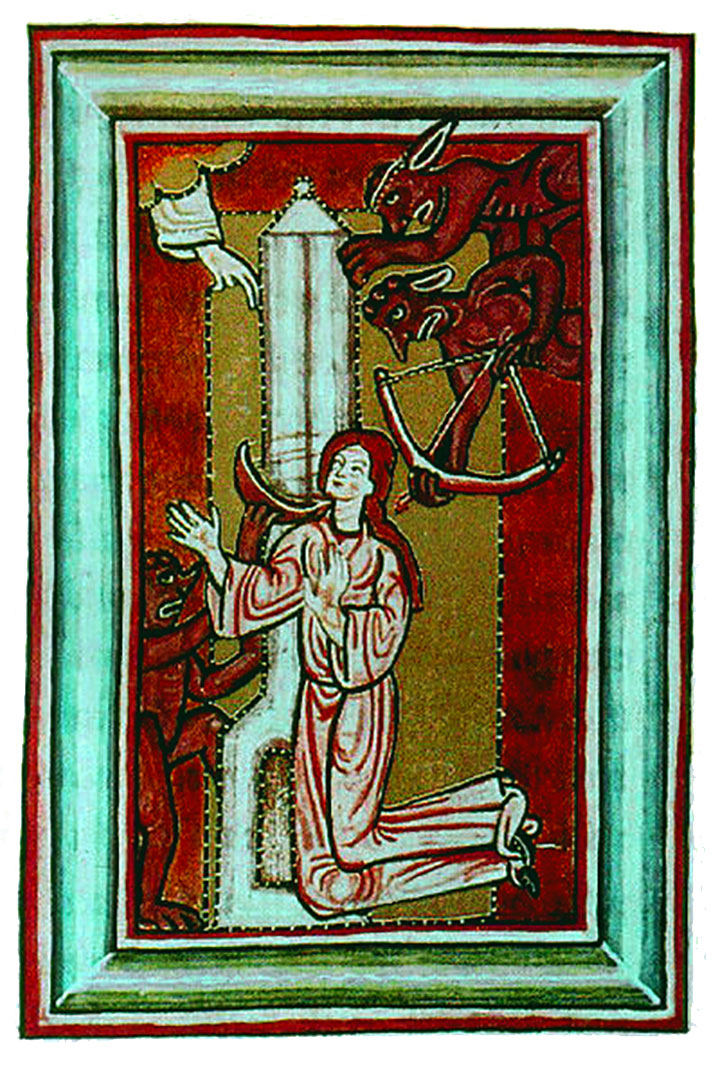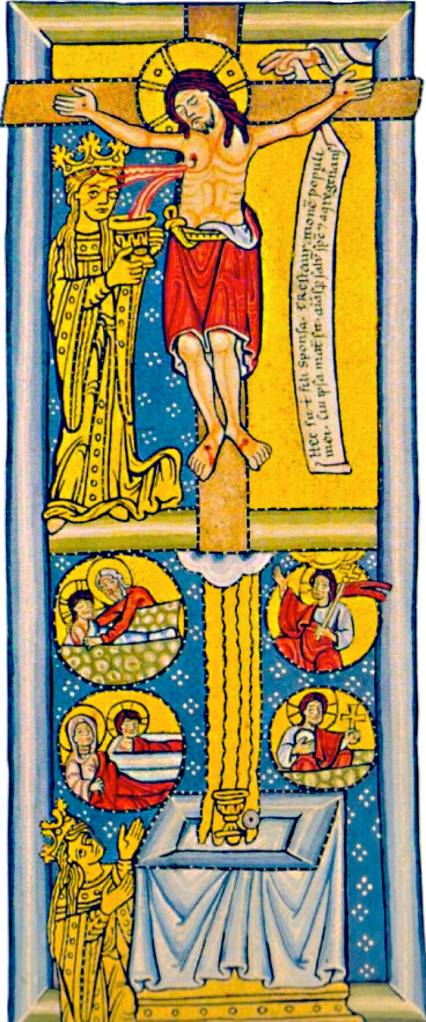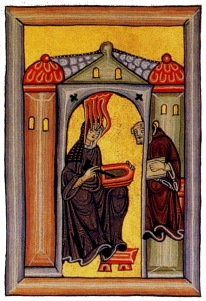Thank you for joining me. This is my first post. Miles of cultural bayou I’ve traversed to arrive at this point of disembark. Sluffs of social media ignorance. Alligators of self-doubt. But I’m here. You’re here. And we’ve gotten on the boat. Come with me!
I’ve brought along someone to help me through the first leg. Hildegard of Bingen (1098-1179). Wikipedia introduces her as “Saint Hildegard” a/k/a “Sybil of the Rhine…a German writer, composer, philosopher, Christian mystic, Benedictine abbess, visionary, and polymath.”
Hildegard?
Meet her…

Above: Hildegard, Magistra (Teacher of Nuns), sketches a vision she’s receiving (see the flames!) on a wax tablet as confessor, Benedictine monk Volmar transcribes her words. Illustration from Scivias (Know the Ways of thy Lord), (1141-1151) the first of Hildegard’s three great theological works.
Hildegard had visions…

This image represents the first of ten visions recorded in Hildegard’s third and final Book of Divine Works, Liber Divinorum Operum (completed 1174).
Hildegard describes her experience:
In middle of the southern sky, I saw a beautiful and mysterious likeness of God—almost a man’s form, with a face of such beauty and clarity that I saw him brighter than day. A wide circle of gold and colors surrounded both his head and face.
Within the circle but above his head another face appeared—of an older man—whose chin and beard were touching the crown of the first head.
And out of his neck extended the wing-forms of a great bird, alternately rising—above the circle—and falling in unity.
At the top of the arch of the right wing was the head of an eagle staring with fiery eyes in which the brightness of angels was reflected. At the top of the arch of the left wing was the face of a man shining as bright as stars and facing towards the east. Each wing extended from shoulder to knee. The tunic he wore shone like the sun, and in his hands he carried the glittering lamb of god.
A dreadful black monster of venomous shape and a serpent he trampled beneath his feet, planting his golden right foot on the mouth of the monster, the rest of the monster’s body lying so its legs and feet extended to the left.
The image spoke:
—”I am the supreme fire and life-force and I ignite life’s spark in all living beings. I breathe no death, except to the judged, embracing the living within the circle of my great wings while surrounding them with the wisdom of flight to bring them into right order.”
Below you see Hildegard receiving the vision, sketching what she sees on a wax tablet. The sketch would be transferred to manuscript and illuminated by a monastic scribe.
To Hildegard’s left, you see Volmar writing down what she’s saying. And behind to the right is her friend, young noblewoman-turned-nun Richardis von Stade. Before the pope’s approval in 1141, Hildegard kept her visions secret. Richardis and Volmar were her only confidants.
And because of her visions, we have her today…
Volmar convinced the abbot of Disibodenberg Abbey, the monastery where Hildegard was abbess, that her visions were from God. Abbot Kuno convinced Henry I, archbishop of Mainz. The archbishop convinced Bernard de Clairvaux who convinced the pope. Pope Eugenius III approved the divinity Hildegard’s visions and in 1141 she was authorized to record them.Which is what we have today.
“And behold, in the forty-third year of my passing course, while I was intent upon a heavenly vision with great fear and tremulous effort, I saw a great splendour, in which a voice came from heaven saying to me:
‘O weak mortal, both ash of ash and rottenness of rottenness, say and write what you see and hear. But because you are fearful in speaking and simple in explaining and unlearned in writing these things, say and write them not according to human speech nor the understanding of human creativity nor according to the will of human composition, but…according to the will of the One Who knows, sees, and disposes all things in the hidden places of his mysteries…Therefore speak these wonderful things and write and say them in the manner they were taught.’
This happened in AD 1141 when I was 42 years and 7 months old: A fiery light, of the greatest flashing brightness, coming out of a cloudless sky, flooded my entire mind and so inflamed my whole heart and my whole breast like a flame — yet it was not blazing but glowing hot, as the sun makes anything on which its rays fall hot…
—Hildegard von Bingen, preface to Scivias, Rupertsberg, 1151
Translation by Dr. Abigail Young, University of Toronto, Ontario, 1984. All rights reserved © 1984, Abigail Ann Young. Used on condition of author’s notification and listing her copyright.
…her words…her images…
and her music…
So take a listen to a 900-year-old songwriter.
Here is Sequentia (gold standard of medieval music performers) performing the antiphon O dulcissime amator. A call-and-answer chant, Hildegard would have led her nuns in what she called “a symphony for the virgins.”
O dulcissime amator—Sequentia
Antiphon solo passages: Pamela Dellal, Nancy Mayer, Consuelo Sañudo, Lucia Pahn. Answering schola/choir: Elizabeth Glen, Janet Youngdahl. From Sequentia’s CD Voice of the Blood, BMG Records, 1995.
O dulcissime amplexator
adiuva nos custodire virginitatem nostram.
Nos sumus orte in pulvere—heu! heu!
—et in crimine Ade
valde durum est contra dicere
quod habet gustus pomi
tu erige nos salvator Christe.
Nos decideramus ardenter te sequi—
O quam grave nobis
miseris est
te immaculatum et innocentem
regem cum angelorum imitari.
Tamen confidimus in te
quod tu desideres gemmam
requirere in putredine.
Nunc advocamus te
sponsum et consolatorem
qui nos redemisti in cruce.
In tuo sanguine copulate sumus tibi cum desponsatione
repudiantes virum
et eligentes te, filium Dei
O pulcherrima forma
O suavissimus odor
desiderabilium deliciarum
semper suspiramus post te,
in lacrimabili exilio.
Quando videamus
et tecum maneamus?
Nos sumus in mundo
et tu in mente nostra,
et amplectimur te in corde
quasi habeamus te presentem.
Tu fortissimus leo rupisti
caelum descendens in aulam virginis
et destruxisti mortem
edificans vitam in aurea civitate.
Da nobis societatem cum illa
et permanere in te,
O dulcissime sponse
qui abstraxisti nos
de faucibus diaboli
primum parentem nostrum seducentis.
O sweetest male embrace
help us to guard our virginity.
We are risen from dust—alas! alas!
—and from the crime of Adam
so hard it is to speak against
the taste the apple gives
but you offer us a savior, Christ.
And burning, we have fallen down to follow you—
O how challenging it is for us,
so flawed,
to try to resemble you,
the unstained, innocent king of angels.
And so we entrust to you
the jewel you desire
and seek from our decay.
Now we call out to you,
bridegroom and comforter
who redeemed us upon the cross.
In your blood, we are joined as a couple in betrothal
repudiating other men
and choosing you, son of God.
O most beautiful body
O sweetest scent
of desired delights
we will always sigh after you
in tearful exile.
When may we see you
and be with you?
We are in the world
and you are only in our minds,
but you are held in our hearts
almost as if you were present.
You the strongest lion broke heaven
descending into the royal court of virginity
You destroyed death
and erected life in the golden city.
Give us citizenship in that city
and let us remain there with you,
O sweetest husband
who seized us
from the throat of the devil
as he led us astray from our primary father.
I have no religious experience of this kind and cannot imagine it. But I can imagine an orgasm. And this is how I’d like to feel.








The Hildegard recording you’ve chosen made me realize for the first time how sensual – frankly erotically sensual – the music is. (The recordings made in the 80s were *nothing* like this!) Squares with the discussion you and I had at Neptune in which I mentioned that Bernini St Teresa of Avila. (Also gives me some insight into my fear of James: now I want you to see the portrait he did of me.) The amalgam of things this blog is raising for me is Amazing.
The interface between your music and this strain of (Christian) mysticism is unexpected. Thanks for your help.
xoD
Danny, you really get the connection between the sensuality and the spirituality. Thank you. More about how the music sounded in the 80s, 90s or 70s and 60s—Hildegard’s or medieval music in general—in the next post. It’s really interesting—the music itself vs. the performance practice and the contemporary cultural influences that shape—consciously or un-—how the music gets interpreted.